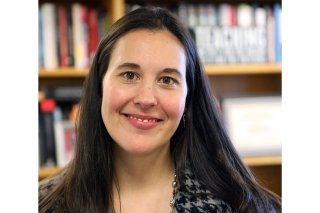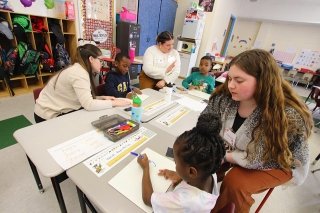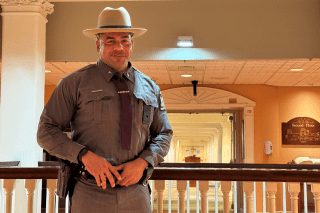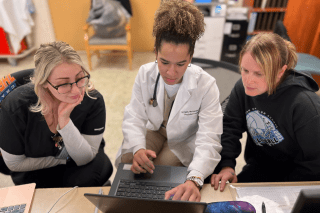Understanding Risk While Taking Chances: Geography Faculty Member was Former CIA Analyst
Posted:

Commonwealth University faculty member Jennifer Haney is an expert in evaluating public risks and hazards.
In her career however, Haney has been unafraid of taking risks herself. As an associate professor of environmental, geographical, and geological sciences at Commonwealth University, Haney is both a Certified Emergency Manager and former CIA analyst.
A 2003 graduate of Bloomsburg, Haney was originally an elementary education major. But, a general education class in environmental issues and choice inspired her to switch her major to geography with an emphasis in environmental planning. “I had taken the Praxis exam and was getting ready to student teach,” says Haney.
“After the geography class, I worked on a research project using GIS (geographic information systems) to digitize old topographic maps,” she adds “It was an interesting experience, and I decided that I was going to change my major to geography and planning. I tell my students that it’s rare that geographers wake up in the morning and say, ‘I’m going to major in geography.’ It just doesn’t happen. Most of them find their way into the discipline by accident. And it’s the same thing with me.”
Changing majors so close to graduation was a bold move. One of several Haney has taken in her career. But it was a move that paid off.
After graduation from Bloomsburg, she earned her master’s degree in geography from Binghamton University and her doctorate in geography from the University of South Carolina.
“Since I grew up in Danville, I did my master’s thesis work here in Bloomsburg and Columbia County studying flood hazards and specifically the vulnerability of the elderly population and how that could impact things like evacuation behavior,” Haney says.
At South Carolina, Haney was a graduate assistant in the Hazards and Vulnerability Research Institute, a unique institution in the country that studied hazards from a geographic or spatial perspective. “I traveled to the Mississippi Gulf Coast after Hurricane Katrina and examined recovery rates among communities and why communities bounced back and rebuilt faster than others,” she says “We used GIS and documented changes with repeated photographs taken every six months.”
She was invited to work on a grant project with the Department of Homeland Security and the START Center based at the University of Maryland, a consortium for the Study of Terrorism and Responses to Terrorism. “That project focused on changing trends in terrorism across time and space. I focused on the domestic angle, and that led to my doctoral work where I looked at changing geographies of eco-terrorism in time and space,” Haney says.
That grant project led Haney to be invited to join the CIA as an analyst. “I was a geospatial analytic methodologist at CIA headquarters in Langley,” says Haney. “And it was great. I really enjoyed what I did. I applied geospatial tools and technologies like GIS and remote sensing to a wide range of problems in the intelligence community.”
“What is a geospatial analysis?” asks Haney. “If you have data with any kind of geo-reference, like latitude and longitude, you can analyze it. So, you just pull from different layers of information only what’s meaningful to answer your specific questions. Say, we’ve had an incident in North Africa, and we need to see what other places share the same characteristics where this could happen again.”
But once again, Haney, a risk expert, took a calculated risk, choosing to leave the CIA for higher education. In 2012, she left a permanent position as a CIA analyst to try something new as a temporary adjunct faculty member. The institution that inspired her to make that leap? Her alma mater, of course.
“I’d expressed interest to my team chief and deputy chief about wanting to teach at a nearby community college during the summer. I wanted to do this to get an additional experience,” Haney recalls. “They said,
‘You’re doing a rockstar job. We don’t want you to focus on other things right now.’ And then this position opened, and I’m like—I’m going to do this. I remember having a conversation with my parents at the time, and they said, ‘You’re leaving a government job for a temporary position. You realize what a risk this is?’ And I was an adjunct for several years here before becoming a permanent faculty member.”
At Commonwealth, Haney has brought insights from these varied experiences to her students at Bloomsburg. She did find that she needed to acquire an entirely new skill set to teach effectively.
“It was horrible,” recalls Haney. “I still have the evaluations from my first semester, and they were brutal. I quickly learned one of the most important lessons of my career. Just because you’re an expert in your field does not mean that you are a good teacher.”
Instead of giving up, Haney leveled up and devoted herself to honing her teaching chops. “I utilized the TALE (Teaching and Learning Enhancement) Center,” she says. I was always in the TALE Center, emailing Lisa Stallbaumer (former TALE director), asking her for her advice and tips. And I participated in the Teaching Excellence Academy.”
The work paid off, and Haney has become a professor who has motivated students to delve deeper into the field. Haney has kept up her industry expertise as a member of the International Association of Emergency Managers and, through that organization, has become a Certified Emergency Manager. This certification must be maintained by continuing education and voluntary work with other government emergency management agencies.
“It’s encouraging seeing students taking introductory classes and then liking those so much that they end up deciding that they want to change majors,” says Haney. “In one semester, I had two students choose minors in geography, and one choose it as a major from an introductory class. And several students are taking another class with me already. That’s probably one of the best compliments to your teaching ... having students that take you in more than one course.”



